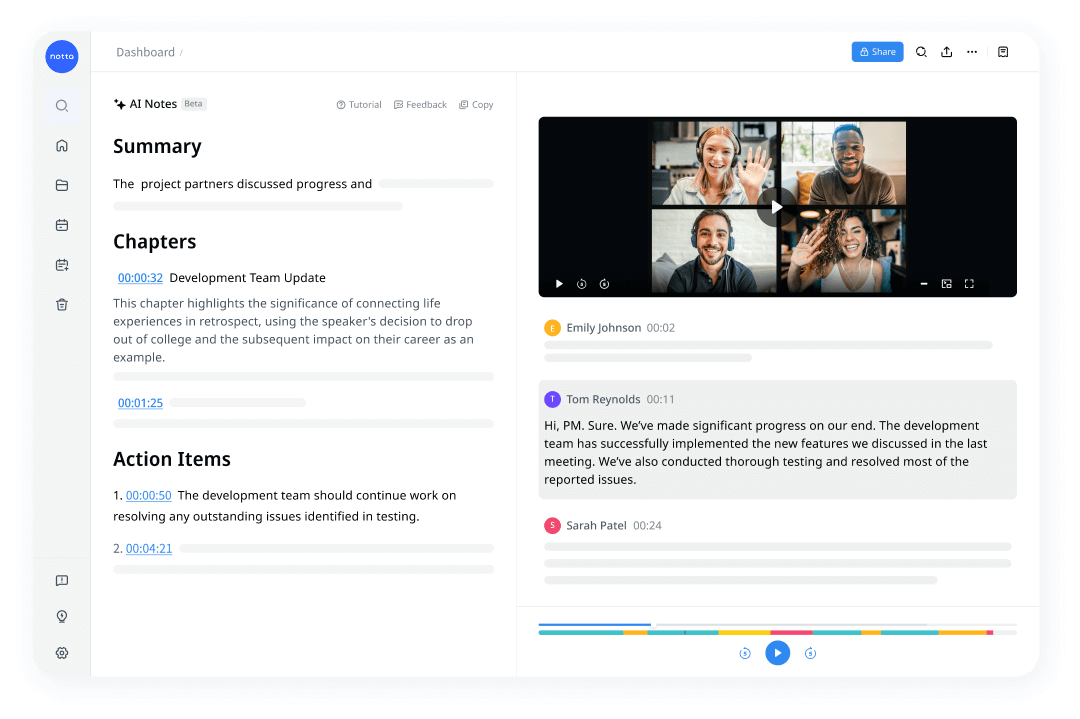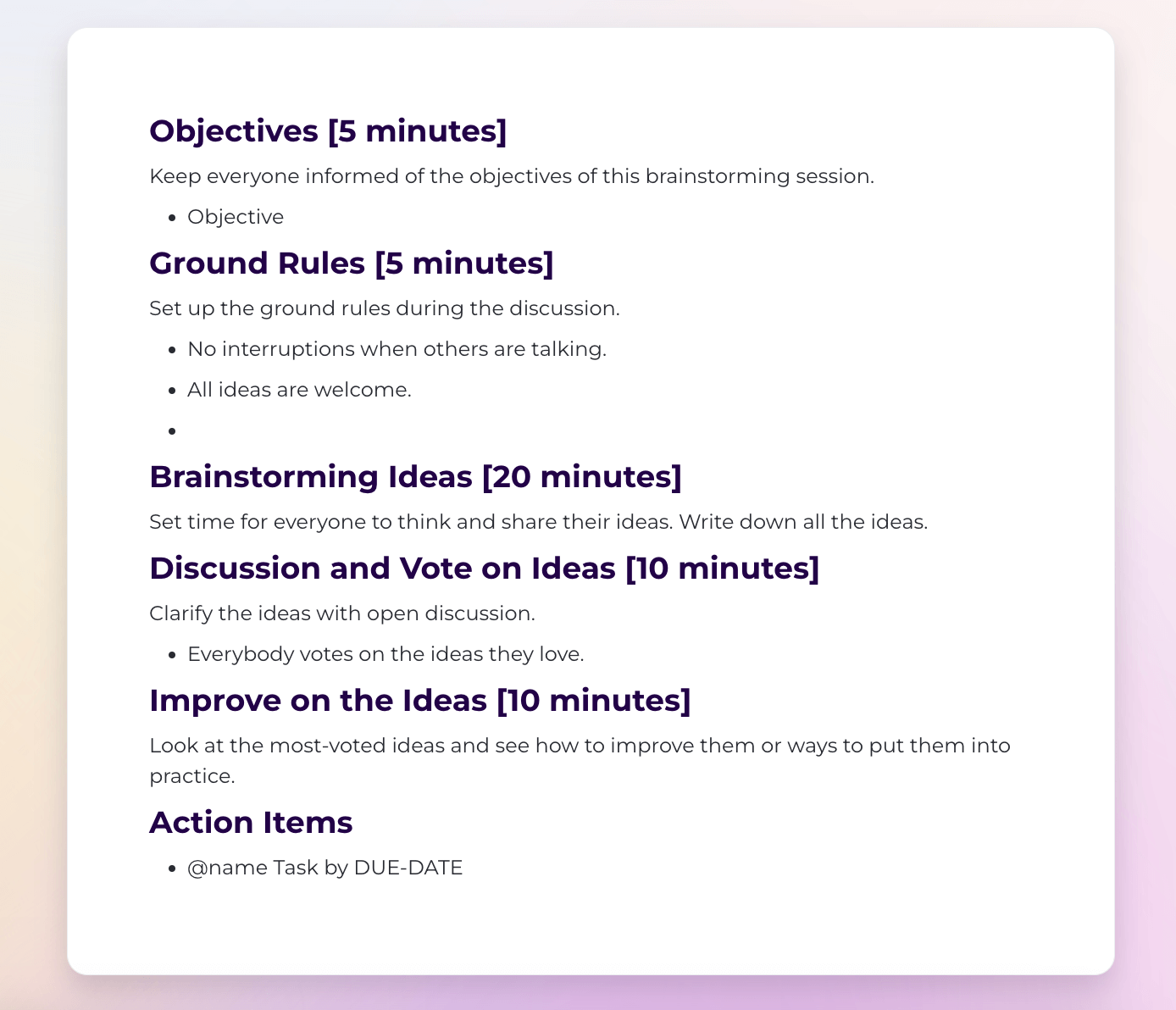
How to Conduct a Successful Brainstorming Session (+ Agenda)
Unlock the power of AI — Notta's meeting assistant records, transcribes and summarizes meeting minutes with one click.
Looking for new ways to generate ideas within your team? A brainstorming session might be what you need.
Not every brainstorming session is an instant success, though. Without the right planning and execution, they can become just another meeting with no tangible outcomes.
This guide will help you organize a successful meeting, from preparing the session and setting rules to creating the brainstorming meeting agenda. Let’s get started!
What is a brainstorming session?
A brainstorming session is a meeting where a group of people gather to generate new ideas or solutions to specific problems. The goal is to encourage creative thinking to come up with as many ideas as possible.
During a brainstorming meeting, everyone is encouraged to share their ideas with no criticism or judgment. All ideas are mapped, organized, and evaluated to prioritize the best solutions to a problem.
You can plan a brainstorming session for a specific team or even explore the idea of a company-wide brainstorming meeting where people from different departments can help solve a bigger problem.
Be careful; you don’t want to invite too many people to the meeting as you won’t be able to keep the session interactive. Ideally, you want to invite three to eight people to the meeting to ensure that everyone has the time and space to share their thoughts.
Why is a brainstorming session important?
The most obvious reason for running a brainstorming session is to get your team to be creative to solve an existing problem. Besides, it provides additional benefits, as listed below.
Improve communication and collaboration. A brainstorming meeting gets your colleagues to interact with each other more creatively. They share ideas in an open-minded environment where everyone is encouraged to participate, even those who tend to be more silent in other meetings.
Introduce different perspectives. Every colleague may bring a unique perspective. Inviting people from different backgrounds to a brainstorming meeting leads to a wide range of ideas and new approaches to solving a problem.
Increase productivity. Setting up the ideal environment to feel creative makes your team feel productive. Instead of having every person brainstorm on their own, you are speeding up the ideation process with group brainstorming techniques. It’s not just about having more ideas, though. You are also able to organize all the available ideas and get everyone to commit to the next actions. This way, the meeting feels faster and more effective.
Conduct a successful brainstorming meeting in 5 steps
Running a brainstorming meeting is all about being organized. All you need is a plan that works for your company.
Here are the five steps to help you plan a successful brainstorming session.
Step 1: Define your brainstorming topic
The first step is to identify the problem and set a clear goal for the meeting. The topic should be tangible and easy to understand and ideally can be defined in one short sentence.
For example, if the problem is ‘customer conversion rate is too low’, then the topic for the brainstorming session might be ‘how to boost conversion rate’.
Here are some tips on how to make this stage work for your company.
Focus on one topic at a time.
You can’t solve too many problems in one session. Focus on one goal per session and make sure it’s specific. You don’t want to mix different topics that confuse your team, do you?
Share the goal with your team.
Everyone should be aware of the topic before the session along with all the necessary information they need to prepare for the meeting. This makes it easier for participants to familiarize themselves with the problem and contribute to the meeting.
Now that you have a clear idea of what you want to achieve, you can proceed to the meeting preparation.
Step 2: Prepare for the brainstorming session
The second step is all about setting the stage. This is the time to prepare for the meeting, organize its structure, and finalize the agenda.
Here is how to start with the planning.
Invite the right people.
Many successful brainstorming meetings involve people from different teams and levels of seniority. Think outside the box, if needed, to ensure the meeting leads to a variety of new creative ideas. Still, everyone you invite should have the experience or the background to make relevant contributions to the topic.
Ideally, you don’t want to have more than eight people in the meeting as this would make participation more challenging. You also need to have a meeting facilitator to keep the session structured and help the team stay engaged.
Organize the tools you’ll need.
Whether it’s a face-to-face or a remote meeting, you still need to prepare the tools to facilitate the brainstorming process and save time.
This could include online voting or mind mapping tools for virtual meetings and sticky notes and whiteboards if everyone is in the same room — to document and organize all ideas.
A timer is also necessary to keep your session going smoothly without procrastination.
Estimate the time required.
As part of the planning, you need to have an estimate of the time the meeting will require. You don’t need to plan the session to the minute yet, but you can still have an idea whether the session will last an hour or half a day. This will help you decide the number of activities you’ll have in the meeting.
Create and share the meeting agenda before the session.
A meeting agenda is a preview of the meeting that helps everyone know what to expect. It not only gets everyone prepared for the meeting but also keeps them on the same page to stay focused on the goal during the ideation process.
You can state the meeting goal, list the agenda items, and even link to additional resources, if necessary, to add more context about the specific problem you want to address.
All meeting participants should have access to the agenda before the session, where they can also get an indication of the required time for each activity.
Step 3: Set ground rules of engagement
It’s easy to assume that you don’t need to spend much time on this step as everyone can guess what a brainstorming meeting is about.
This is only partly true; setting engagement rules beforehand helps get everyone to participate and create an engaging and productive session.
You should inform everyone of the rules for discussion before the meeting begins. Below are some common ones:
Focus on quantity. At this stage, you don’t need to think about quality yet. The more ideas, the merrier. This is why many brainstorming techniques are all about speed so that you don’t spend too much time brushing up your answers.
All ideas are welcome. All members are encouraged to share their ideas as the purpose of brainstorming is to generate as many ideas as possible. It’s up to the facilitator to maintain an open environment where everyone can share their ideas.
Avoid judgment and criticism. Your team should know that there are no right and wrong ideas and never show disagreement when others propose an idea. This is not about comparing who came up with the best ideas.
No interruptions when others are talking. A successful brainstorming meeting relies on effective communication at any time. The facilitator is responsible for giving space to all participants to express their thoughts without interruptions from others.
Building on other ideas is encouraged. A big benefit of running group brainstorming meetings is to help each other shape an idea by continually building on it. This is a great approach to improving teamwork while collecting ideas coming from different perspectives.
Step 4: Start the brainstorming session
Now that you’ve done all the prep work, it’s time to start the meeting. Start with why we are holding this meeting and the expectations to get everyone focused on the goal.
Here are some practical ways to ensure the brainstorming session is successful.
Get everyone involved.
The best way to generate many ideas is to encourage participation. Everyone in the meeting should feel creative and confident to share any idea without judgment.
You can even explore specific brainstorming techniques that get everyone to share their ideas. We’ll explain more about this in the next section.
Keep track of time.
Being strict with the allocated time for each activity will make sure the meeting ends at the estimated time. Imagine starting the session with everyone taking turns to share an idea. Without timekeeping, this activity could last the whole session.
Be clear with the time limits from the start and share a reminder a few minutes before the end of each activity.
Capture and organize all ideas.
There are no good or bad ideas so make sure you collect them all. Whether you are using sticky notes, a whiteboard, or have them all captured with a digital note-taking tool, you still need to organize them in one place before you evaluate them.
You can create different tags to sort out the ideas based on the area of focus, their urgency, or their impact. By tagging the ideas right when you organize them, you are speeding up the process of reviewing them and finding the ones that are more relevant at different times.
Evaluate and prioritize ideas.
Now it’s time to review all ideas to prioritize the ones that are more relevant to your goal. Going through all the ideas may seem like a time-consuming process, but it can still help you explore different perspectives that may be useful in more than one instance.
You can evaluate the ideas based on their feasibility, the time it would take to implement them, or the impact they would have.
The ‘Effort/Impact Matrix’ method can make it easier to prioritize the ideas to spot the ones that require a low effort but still lead to high impact.
Step 5: Summarize and define the next steps

Before ending the brainstorming meeting, you need to create a summary of the session and plan the next steps. Having some sort of documentation makes it easier to refer back and share the outcome of the meeting with the rest of the company.
Take a photo of the post-its (or a screenshot of the virtual board).
As simple as it sounds, a photo of the post-its from the ideation process makes the easiest way to document your process.
If you want to be more specific, write a summary of the generated ideas in bullet points and the brainstorming methods you used to inspire the ideas.
Assign tasks and get everyone to commit to the next steps.
Brainstorming has no value if we don’t put the ideas into practice.
We should work together to create an action plan that is practical and realistic based on the discussion.
Assign tasks to those involved and get them to commit to one action they will do within the week. Once the first action is complete, ask them to create a more detailed plan to share with the rest of the team.
Create a sub-group to review the best ideas in more detail.
During the meeting, you may come up with great ideas that require long-term planning. You may even accidentally solve a different problem. Even if such ideas don’t contribute to the goal of the specific meeting, it’s still useful to review them in more detail.
For example, a customer success brainstorming session can lead to creative marketing ideas based on what customers want from your brand. They may not be fully relevant to the customer success team, but you can invite the marketing team to a meeting to run the ideas with them.
Notta offers the most integrated AI meeting notes, summaries, and action items so nothing gets missed.
4 group brainstorming techniques you should know
There are many brainstorming techniques out there to foster creativity as part of a group. Each method is based on a different approach, and you can include multiple techniques within the brainstorming meeting to ensure that the team generates as many ideas as possible.
Let’s find out more about four popular group brainstorming techniques and how you can use them in your next meeting.
#1: Brainwriting
This is a non-verbal brainstorming method that encourages collaboration within the team to shape each idea.
Everyone on the team has 5 minutes to come up with three ideas that are relevant to the key topic. Once the time is over, they pass the ideas to the person on the right to continue building off the idea. The goal is to pass each idea around until everyone in the group has contributed to it. Once the ideation process is over, the team reviews the ideas to choose the ones to focus on.
This is a good technique for team members to spend time on silent thinking while still working with their teammates to build an idea. It helps everyone in the group to have an equal share in the brainstorming session, which makes it easier to motivate them to implement the idea later on.
If you are planning a virtual brainstorming meeting, you can use online collaboration tools to create a similar experience for your session.
#2: Rapid ideation
This is a simple but very effective method. Everyone has a set amount of time, for example, ten minutes, to write down as many ideas as possible.
There are no second thoughts or time to evaluate an idea. This is about speed and creativity. It is an effective method to help attendees get rid of their inner critics or the overthinking that gets them to spend too much time on one idea.
Be strict with the timekeeping in this section to create a sense of urgency in the brainstorming process.
#3: Mind mapping
This is a visual brainstorming technique for the analytical minds within the team. Everyone starts with one idea and they are asked to expand through additional layers that lead to a visual mind map.
Let’s say you are part of a brainstorming meeting on how to improve virtual onboarding in the company. You come up with the idea to set up an online “meet and greet” between the new colleague and the existing team. Once you write down this idea, it’s time to connect it to the sub-ideas.
You can add more details to the idea, such as the next steps or the challenges you may address when trying to implement it. In the end, you should be able to have a visual overview of a complete idea.
#4: Round-robin brainstorming
If you want to encourage participation by everyone in the group, this is a great technique to use.
The concept is simple. Everyone in the group has to share an idea. You can’t share a second idea unless everyone has shared their first idea. If you come up with the idea that someone mentioned just before you, you need to come up with a new one.
In other words, you can’t skip your turn simply because someone has the same idea as you. You can take your time and think of a new one to share.
It’s a fun method that helps everyone feel involved and get an equal share in the creative process.
Brainstorm meeting agenda template
The best way to keep the brainstorming meeting structured is to have a meeting agenda in place.
The agenda helps attendees prepare for the session by knowing what to expect, the activities they’ll join, and the time they will need for each one of them.
Instead of starting from scratch, here is an example of a brainstorming meeting agenda created by meeting professionals that you can apply and customize to your needs.

Maximize your team’s brainstorming meetings
A brainstorming meeting can be a great opportunity for your team to come together and find creative solutions to problems.
You don’t need to be an experienced facilitator to plan the session. All you need is the time to prepare the topic, the engagement rules, and the techniques you’ll use to keep everyone motivated.
Ensure you create an inclusive environment with no judgment or interruptions to unlock everyone’s creativity. After all, the ultimate goal is to generate as many ideas as possible.